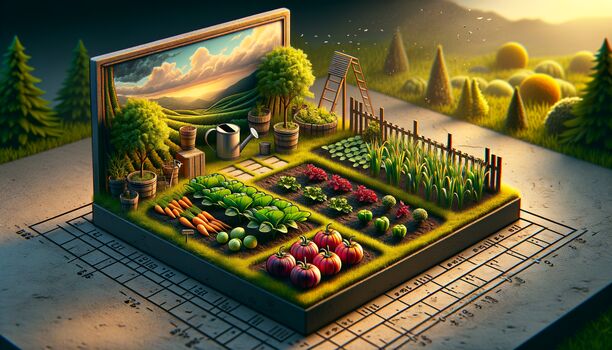


Letztes Update: 13. September 2025
Explore how to implement crop rotation in a small garden to enhance yield and soil health. Learn to plan, execute, and track crops effectively across seasons.
Hello fellow gardeners! I'm diving deeper into sustainable gardening practices and have come across the concept of crop rotation. Specifically, I'm curious about how to implement crop rotation in a small garden space. From what I understand, it's a powerful way to improve both yield and soil health, but I'm a bit lost on how to start, especially with limited space.
Could anyone share insights or tips on how to effectively plan and execute crop rotation in a small garden? I'm particularly interested in how to manage this process over the seasons and how to choose which crops to rotate. Also, how does one keep track of which areas have hosted certain types of crops to ensure a proper rotation cycle?
Moreover, I've read that certain crops can benefit the soil in different ways. How do I determine which crops will complement each other from one season to the next in a small garden setting?
I'm aiming to make my gardening practices more sustainable and productive, and I believe mastering crop rotation in a small garden could be a key step. Any advice or resources you could recommend would be greatly appreciated!
Last updated 3 mins ago
Antwort der Redaktion
Implementing crop rotation in a small garden can significantly enhance both yield and soil health. This sustainable gardening practice involves changing the types of crops grown in a specific area from season to season. Here’s a detailed guide to help you get started.
Crop rotation involves alternating the types of crops you plant in your garden beds. This practice helps prevent soil depletion, reduces pest and disease buildup, and can improve soil structure and fertility. In a small garden, it’s crucial to plan carefully to maximize these benefits.
Begin by dividing your garden into sections. Even in a small garden, creating distinct areas for different plant families can make rotation more manageable. Consider grouping plants by their botanical families, such as legumes, brassicas, and nightshades, as these groups have similar nutrient needs and pest profiles.
Select crops that complement each other in terms of nutrient requirements and pest resistance. For instance, legumes can fix nitrogen in the soil, benefiting nitrogen-demanding crops like leafy greens in the following season. Research which crops thrive together and plan your rotations accordingly.
In a small garden, space is limited, so creative solutions are necessary. Consider vertical gardening or intercropping to make the most of your space. Rotate crops annually, ensuring that no plant family occupies the same spot for consecutive years.
Keep a garden journal to record where each crop is planted. This will help you track your rotations and make informed decisions for future planting. Documenting your garden’s layout each season ensures you maintain a balanced rotation cycle.
Crop rotation in a small garden not only improves soil health but also enhances biodiversity and reduces the risk of pests and diseases. By diversifying your plantings, you create a more resilient garden ecosystem.
Mastering crop rotation in a small garden requires careful planning and a keen understanding of plant relationships. By rotating crops effectively, you can boost your garden’s productivity and sustainability. Start small, keep detailed records, and watch your garden thrive.
Last updated 3 mins ago
If you're diving into the world of gardening, especially focusing on crop rotation in a small garden, you've made a great choice for both your garden's yield and soil health. Crop rotation is a crucial practice that can significantly enhance your garden's productivity and sustainability. It involves changing the types of crops grown in a particular area with each season or year, which helps in preventing soil depletion and reducing pest buildup. But, how do you start, and what do you need to know?
One essential aspect of managing a small garden space effectively is understanding the soil's condition. Before you plan your crop rotation, you might want to check out "What are the key indicators that my soil is healthy and how can I improve its quality over time?" This resource will give you insights into identifying the health of your soil and methods to enhance it, ensuring your crop rotation plan is built on a solid foundation.
Another important consideration for small garden spaces is composting. Sustainable composting methods can greatly improve your soil's fertility, making it more receptive to your crop rotation efforts. For urban gardeners looking to adopt eco-friendly practices, "Can anyone recommend a sustainable composting method for small urban gardens?" offers valuable tips and techniques for creating nutrient-rich compost even in limited spaces.
Lastly, dealing with pests naturally is a common concern when implementing crop rotation in a small garden. To complement your crop rotation strategy, learning about natural pest control methods can be incredibly beneficial. The article "How can I naturally repel pests from my vegetable garden without using harsh chemicals?" provides excellent advice on keeping pests at bay using safe, natural remedies, ensuring your garden thrives without the need for harmful chemicals.
By focusing on these aspects, you'll be well on your way to mastering crop rotation in your small garden, leading to improved yield and healthier soil. Happy gardening!